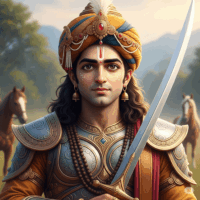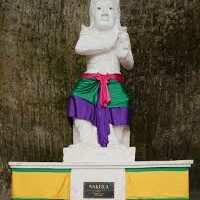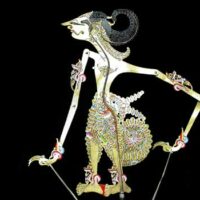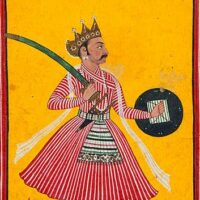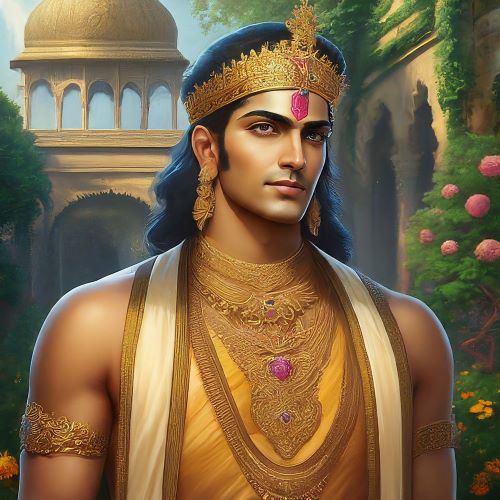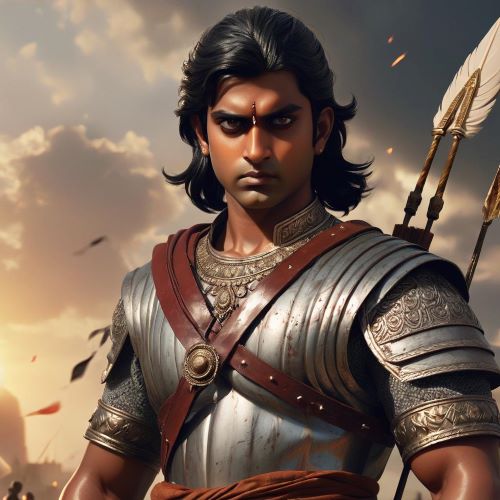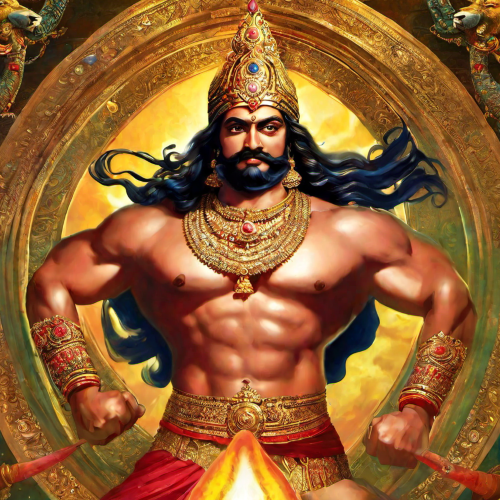Nakula : The Handsome Pandava
Listen
At a glance
Nakula
Introduction
Nakula, one of the five Pandava brothers in the epic Mahabharata, often stands in the shadows of his more prominent siblings like Arjuna and Bhima. Yet, his role in the great saga is both unique and essential. Born to Queen Madri through the divine intervention of the Ashvini Kumaras—celestial twin gods known for their healing abilities—Nakula’s presence in the epic brings a blend of charm, skill, and humility. Though not the loudest or most celebrated Pandava, his contributions, both in war and peace, are invaluable to the larger narrative.
Physical Traits
In the Mahabharata, Nakula is praised as the epitome of male beauty. He is frequently likened to Kamadeva, the god of love, for his flawless features and striking grace. With a tall and athletic build, dark complexion, and expressive eyes, his presence captivated those around him. Yet, his physical beauty was not merely superficial—it mirrored his composed demeanor and balanced personality, qualities that distinguished him from the more impulsive members of his family.
Family
Nakula’s birth came through a divine boon granted to Madri, King Pandu’s second wife, who invoked the Ashvini Kumaras to overcome Pandu’s curse of infertility. He and his twin, Sahadeva, were raised under the care of Kunti, their stepmother, following the death of both their parents. This unique family dynamic fostered a strong bond among the Pandavas, who regarded each other not only as brothers but as allies and protectors. In addition to sharing Draupadi as a common wife with his brothers, Nakula also married Karenumati, a princess of Chedi. His lineage continued through his sons, Shatanika and Niramitra.
Other names
Nakula is known by several names that reflect different facets of his origin and identity. Terms like Āśvineya, Aśvinīsuta, and Aśvisuta highlight his celestial parentage. Other titles such as Mādreya and Mādrinandanaka underscore his maternal lineage from Madri. During the Pandavas’ exile, he took on the persona of Granthika, a horse caretaker—a role that further revealed his mastery over equestrian sciences and his comfort with humble tasks.
Powers and Abilities
Trained by the formidable Guru Drona, Nakula mastered several martial arts, particularly swordsmanship and archery. In battle, he fought with precision and elegance, playing pivotal roles in multiple encounters during the Kurukshetra War. His calm and composed style of combat was a contrast to the brute strength of Bhima or the fiery precision of Arjuna.
One of Nakula’s most distinctive strengths lay in his expertise with horses. His understanding of horse breeding, training, and care was unmatched, which made him crucial in managing the Pandava cavalry. This equestrian excellence was likely an inheritance from the Ashvini Kumaras, who are also linked to veterinary knowledge. Moreover, Nakula was well-versed in Ayurveda and possessed a deep understanding of natural medicine, further emphasizing his divine connection to healing arts.
Beyond physical and intellectual talents, Nakula also demonstrated a level of intuitive foresight. On rare occasions, he is said to have received glimpses of future events—mystical insights that faded like dreams upon waking. This trait, though subtle, added an element of spiritual depth to his character.
Modern Day Influence
Nakula may not dominate the Mahabharata’s central plot, but his presence has quietly echoed through the centuries. His sense of humility and grace, despite his many gifts, serves as a powerful moral lesson. In the epic’s final journey to the Himalayas, he is the third Pandava to fall. Yudhishthira explains that Nakula succumbed to vanity over his looks—an insight that reveals the fine line between virtue and flaw, even among the noble.
His story is preserved in traditional art forms like the Indonesian Wayang kulit (shadow puppet theater), where his character often appears as a calm and refined warrior. In Indian storytelling traditions, Nakula’s life is used to explore themes of modesty, loyalty, and inner discipline.
In modern retellings—through novels, television series, and spiritual discourses—Nakula continues to be portrayed as a paragon of quiet strength. His balanced persona has gained new relevance in an era where humility and composure are valued amidst chaos and competition. Some spiritual interpretations even view Nakula as a symbol of beauty in service of virtue, reminding followers that outward grace must align with inner purpose.
Related Images
Source
Ganguli, K. M. (1970). The Mahabharata (Vols. 1-12). Munshiram Manoharlal Publishers Pvt. Ltd.
Nakula – Wikipedia. (2004, December 12). Retrieved May 28, 2025, from https://en.wikipedia.org/wiki/Nakula
Nakula – Google Arts & Culture. (2025, May 5). Retrieved May 28, 2025, from https://artsandculture.google.com/entity/nakula/m04np_b?hl=en
Nakula – The Fourth Pandava – Apam Napa. (2023, November 8). Retrieved May 28, 2025, from https://apam-napat.com/nakula/
Nakula, Nakulā, Nākula, Na-kula: 35 definitions – Wisdom Library. (2024, October 24). Retrieved May 28, 2025, from https://www.wisdomlib.org/definition/nakula
Nakula – The Fourth Pandava – Apam Napa. (2024, November 15). Retrieved May 28, 2025, from https://apam-napat.com/entities-nakula/
Wilkins, W. J. (2009). Hindu Mythology. D.K. Printworld (P) Ltd.
Knapp, B. (1984). Indonesian Theater: A Journal. Anima, 11(1), 47-61.
O’Flaherty, W. (1988). Textual Sources for the Study of Hinduism. Barnes & Noble Books.
Williams, G. M. (2003). Handbook of Hindu Mythology. ABC-CLIO, Inc.
Frequently Asked Questions
What is lorem Ipsum?
I am text block. Click edit button to change this text. Lorem ipsum dolor sit amet, consectetur adipiscing elit. Ut elit tellus, luctus nec ullamcorper mattis, pulvinar dapibus leo.
What is lorem Ipsum?
I am text block. Click edit button to change this text. Lorem ipsum dolor sit amet, consectetur adipiscing elit. Ut elit tellus, luctus nec ullamcorper mattis, pulvinar dapibus leo.
What is lorem Ipsum?
I am text block. Click edit button to change this text. Lorem ipsum dolor sit amet, consectetur adipiscing elit. Ut elit tellus, luctus nec ullamcorper mattis, pulvinar dapibus leo.
What is lorem Ipsum?
I am text block. Click edit button to change this text. Lorem ipsum dolor sit amet, consectetur adipiscing elit. Ut elit tellus, luctus nec ullamcorper mattis, pulvinar dapibus leo.
What is lorem Ipsum?
I am text block. Click edit button to change this text. Lorem ipsum dolor sit amet, consectetur adipiscing elit. Ut elit tellus, luctus nec ullamcorper mattis, pulvinar dapibus leo.


